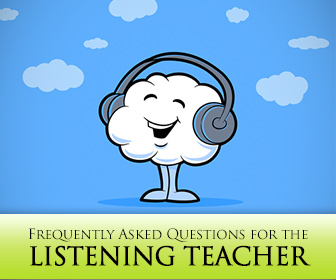10 Great Sources for Real Listening Practice: Part Two


By nature, we have adventurous spirits (especially those who teach overseas). We are good communicators and have a knack for understanding what people are trying to say. We are creative, enthusiastic and have a gift for teaching. But the best teachers have one more thing – experience. The good news is, not all experience has to come from the school of hard knocks. Some experience comes through the advice of others, of those who have gone before us and tackled the same challenges we are now facing. I for one am thankful for all my fellow teachers who helped me become the ESL teacher I am today. Here is some of their advice (and a little of my own) that may also help you in your teaching journey.

Different students will need different amounts of repetition when it comes to listening segments. Generally speaking, three times through a listening activity will be enough. On the first time through, students will just be getting their bearings – trying to determine the context and overall purpose of the conversation. On the second time through, students will be able to get more details. After the second time listening, they should be able to answer general comprehension questions and have a good idea of what the speakers were trying to get across in their dialogue. On the third time through, your students should be able to listen for specific information and details. Giving them comprehension questions before the third time through a listening piece will help them hear the answers, and almost all listening students will prefer that to getting the comprehension questions after they finish listening. Even with all that practice and guidance, some students will still struggle with a listening segment. When this is the case, making a recording available during office hours or at a listening lab will give these students the control to listen as often as they need to so they are able to get what they need to from the listening segment. The important thing is to stay calm and patient when your students struggle with listening exercises. Odds are they are far more frustrated than you are anyway.
You can find listening material just about anywhere. Some of my favorite sources are YouTube and other online videos. I also like to use clips from movies (Netflix is great if you have wifi in your classroom) and television shows. Keep in mind, though, that most of these videos will be very challenging for your students’ listening skills, even advanced students. For beginning and intermediate students, I am more careful in selecting my listening materials. Sometimes, the best source is a recording you make yourself from an original dialogue. Getting a couple of friends together to do a reading of a simple conversation is quick and easy, and it may be all that your students are able to understand. Plus it helps them to hear voices other than your own and those that don’t belong to ESL teachers. You can also help your lower level students by providing a transcript of the listening segment, whatever it is, so they can follow along. It will decrease their listening anxiety and aid in their comprehension. Being more selective in the videos you use can also help lower level students. Choosing segments with clear and slower pronunciation, like news programs or children’s programs, may fill your students’ need for challenging but not too challenging listening material. Of course, ESL teachers have many options for listening curriculum and material if they choose to purchase books and audio resources and they have the budget to do so.
The short answer is no. No one understands every word of what they hear, even native speakers. Listeners use tools like making inferences, making predictions, questioning, visualization and context clues to fill in any comprehension gaps they might encounter. Teaching your students to use these tools as they listen in English, just as they do in their native languages, will help them have a good level of comprehension without requiring them to understand every single word in a listening passage. The hardest part, though, may be countering your students’ desire to understand every word they hear. Some students will think that they cannot achieve good comprehension if they do not understand every spoken word. Teaching them that this is not a realistic or reasonable goal may be harder than teaching them the skills to actively listen, but doing so will serve them better in the long run.
To be completely honest, yes. Your regional accent will affect your students and their knowledge and comprehension of English. “But I don’t have an accent,” you might say. The truth is that everyone, no matter what part of the English speaking world they come from, has an accent. Some are more pronounced than others (the American south or London, for example), but everyone has one, and the ESL students in your listening class will learn to pronounce English words the way you do. That means, depending on where they are studying and where you are from, they may have a more pronounced dialectal accent which may hamper comprehension of other English speakers. As a teacher, your goal should be to minimalize your own accent to help your students learn the best English possible. ESL teachers should therefore learn to approach what is known as “newscasterese” in their pronunciation. If you have watched news programs in different areas of the country, you may not have noticed that the reporters don’t seem to have an accent. Part of a reporter’s job is to approach as neutral English pronunciation as possible. Because of this, their own accents are often neutralized. When you teach, you should also try and approach this neutralized English pronunciation. It may take some practice, and a habit of watching the evening news, but it is worth the effort since your students will become better English communicators and you will become a better English teacher.
Teaching listening can be one of the most challenging classes for an ESL teacher, often because it is the most challenging class for ESL students. Ultimately, being patient and understanding will be the best strategy you can take for teaching listening in English.